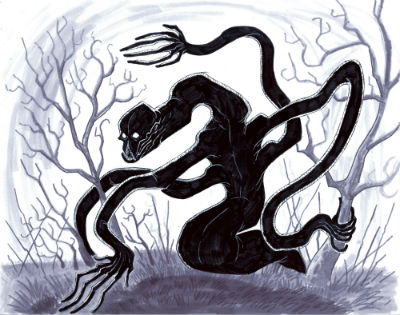A transcript of this episode is now available.
This week’s episode is on “The Mandrakes.” At the beginning of the episode, we noted a change in our line-up and an error we’d made regarding story order. The proper story order is reflected on our About page, although we kept Colossus where it had been and noted where it should have been.
The movie Phil referenced about a woman whose feelings flow into her cooking was Like Water for Chocolate (1992). The Japanese horror film was Cure (1997).
Information about Gilles de Rais can be found here. De Rais was also hanged, but the article does not mention whether or not his corpse was then burned.
The Winners of our Giveaway
Many congrats to the winners of our giveaway, whose “lost or unwritten Averoigne story” ideas were read on the podcast today:
From Jason:
In the decaying ruins of an unnamed abbey, a young woman finds a manuscript purporting to be a true and accurate account of the habits and deeds of the wild loup-garou. She returns to her village and becomes obsessed with proving the validity of the document (and the veracity of the existence of the feral beasts) to the disbelieving townsfolk, going so far as to maul an old woman in a manner consistent with the manuscript to provide “evidence.” She is caught and cast out of the village, wandering in madness through the primeval forest until, joyously vindicated at last, she meets her death on the claws and teeth of a loup-garou.
Guido:
In modern day Averoigne two friends embark on a road trip to sight see the horror haunted historical sights of the Averoignian countryside. Their adventure turns perilous when they realize that their journey is closely tailed by a stalking, flesh-hungry werebeast and they have to keep moving to survive.
Janey:
A highwayman is hiding out in the woods of Averoigne at night when he comes upon a young woman; she tells him a disturbing story about a village whose inhabitants were picked off one by one by a loup-garou. At the end of the story the girl reveals that she herself was the loup-garou, and devours him.
Pete:
The body of a sorcerer washes up on the shore of the Isoile River; whispers of his death begin surfacing around Averoigne and of the binding spell that died with him. Now free from the sorceries that imprisoned their shapeshifting abilities, an ancient family attempt to reclaim their wolfen birthright.
Thanks to all the listeners who submitted and promoted the contest!
Next time, we’ll be doing the published version of “The Beast of Averoigne.” For extra credit, though, read the original version of the story to understand the style he first intended and get a little more background than we’re given in the final version.
Music by: Kevin MacLeod and T.H. Larsen/Gracehoper (with permission) Egypt-style soundscape and Southern Gothic.
Podcast: Play in new window | Download (34.5MB)
Subscribe:






